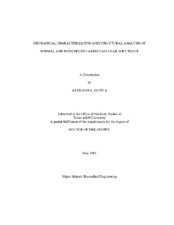| dc.contributor.advisor | Criscione, John C. | |
| dc.creator | Kotiya, Akhilesh A. | |
| dc.date.accessioned | 2008-10-10T20:55:12Z | |
| dc.date.available | 2008-10-10T20:55:12Z | |
| dc.date.created | 2008-05 | |
| dc.date.issued | 2008-10-10 | |
| dc.identifier.uri | https://hdl.handle.net/1969.1/85903 | |
| dc.description.abstract | Characterization of multiaxial mechanical properties of cardiovascular soft tissue
is essential in order to better understand their growth and remodeling in homeostatic
conditions and in response to injury or pathological conditions. Though numerous
phenomenological models have been proposed to characterize such multiaxial
mechanical behavior, the approach has certain drawbacks regarding experimental
determination of the model coefficients. We propose a method that aims to overcome
these drawbacks. The approach makes use of orthogonal polynomials to fit the biaxial
test data and suggests a way to derive the strain energy function from these analytical fits
by way of minimizing the deviation of the behavior from hyperelastic ideal. Using the
proposed method, a strain energy function for a lymphatic vessel is derived and the
method is compared with traditional ones that used non-orthogonal polynomials as
independent variables in the functional form for strain energy. The unique coefficient
values obtained using the proposed method, for the first time gives us an opportunity to
attribute a physical characteristic of the material to the coefficient values. The method
also provides a way to assess two different material behaviors by way of comparing their
deviation from the hyperelastic behavior when a similar test protocol is used to collect
the data, over a similar deformation range and the order of polynomial function is chosen
so as to give a similar error of fit. The behavior of mesenteric lymph vessels from
normal cows, cows subjected to sham surgery and those subjected to 3 days of
edematous conditions by venous occlusion are compared using this method. To be able
to better understand the changes in mechanical behavior, morphological analysis of the
vessels was carried out and the geometric and structural changes in these vessels were
studied. We found that the behavior of bovine mesenteric lymph vessels subjected to a high flow condition shows a small difference in their mechanical behavior as compared
to the vessels from normal a cow and a cow subjected to sham surgery. The geometry
and structure of these vessels also showed marked differences from the other two. The
thickness to radius ratio increased and a rise in percentage of area occupied by smooth
muscle cells and medial collagen was observed. Though not all the differences were
statistically significant, we conclude that the behavior and the morphology are
suggestive of the remodeling of the vessel in response to altered hemodynamic
conditions and require further investigation. | en |
| dc.format.medium | electronic | en |
| dc.language.iso | en_US | |
| dc.publisher | Texas A&M University | |
| dc.subject | Biaxial testing | en |
| dc.subject | Constitutive modeling | en |
| dc.subject | Growth and remodeling | en |
| dc.subject | Lymphedema | en |
| dc.subject | Lymph morphology | en |
| dc.title | Mechanical characterisation and structural analysis of normal and remodeled cardiovascular soft tissue | en |
| dc.type | Book | en |
| dc.type | Thesis | en |
| thesis.degree.department | Biomedical Engineering | en |
| thesis.degree.discipline | Biomedical Engineering | en |
| thesis.degree.grantor | Texas A&M University | en |
| thesis.degree.name | Doctor of Philosophy | en |
| thesis.degree.level | Doctoral | en |
| dc.contributor.committeeMember | Humphrey, Jay D. | |
| dc.contributor.committeeMember | Quick, Christopher M. | |
| dc.contributor.committeeMember | Stewart, Rudolph | |
| dc.type.genre | Electronic Dissertation | en |
| dc.type.material | text | en |
| dc.format.digitalOrigin | born digital | en |


